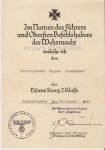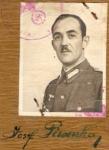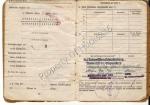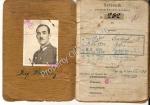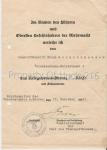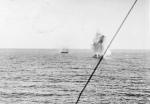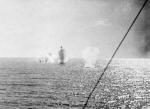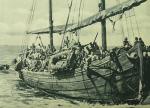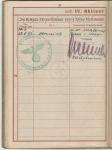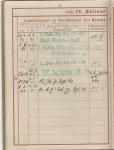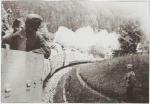-
Posts
3,591 -
Joined
-
Last visited
-
Days Won
8
Content Type
Profiles
Forums
Blogs
Gallery
Events
Store
Everything posted by hucks216
-
The most recent (i.e. today) addition to my collection. EK II & I and Fighter Clasp citations to Oberfeldwebel Magnus Brunkhorst who flew with 9./JG-2 Richtofen. His EK's were awarded during the Battle Of Britain receiving the EK II on 28th August 1940 and then the EK I on 28th October 1940 but by the latter date he had only one 'kill' - a Spitfire on 18th August. Looking through Battle Of Britain Then & Now the only 2 Spitfire casualties for that day that match the location (Isle Of Wight) & time (1559 German Time) of Brunkhorst's claim both made it back to base with damage but both pilots unharmed. It seems strange to win both awards with just a solitary kill, especially as I have an EK II citation awarded to a pilot of JG 51 during the BoB and he had shot down 3 aircraft by the time of his award so a little more digging may well be required to find out the 'why's and wherefores'.
-
'Needle and haystack' sprint to mind I'm afraid. There are organisations such as WASt that provide details on KIA/MIA German soldiers (although usually only to next of kin) but they would need the name and probably date of birth. Volksbund provide an online database for those KIA/MIA but again, you need at least a surname to obtain details of where & when he was born & killed. Maybe there is something in one of the archives in Germany & USA for his unit that can provide some sort of clue but that could be very time consuming and could have no end result for your efforts.
-

Heer WW2 Kriegs Chronik
hucks216 replied to AlecH's topic in Germany: Third Reich: Research, Documentation & Photographs
Very nice item. Strange how they go to all that effort and yet don't bother to put the units he served in. -
During the entire invasion of Crete, 5 GJD reported 20 Officers & 305 men killed and 18 Officers & 488 men missing with the vast majority of these missing men being those lost at sea. Vislmeier's name can be seen on this memorial list for the Maleme War Cemetery... http://denkmalprojekt.org/misc_laender/maleme_iii_btl_geb_jaeg_rgt100.htm This is one of the caiques that III/GJR 100 tried to cross to Crete in and it is easy to see how much of a sitting duck they would of been in face of a proper naval force..
-
Part of the plan was for a large force of III./GJ Rgt 100 to be shipped across to Crete from Greece in 2 flotillas of caiques and two small steam ships with a minimal escort of Italian destroyers, namely the Lupo protecting one force and the Sagittario protecting the other. During the afternoon of 20 May, allied aerial reconnaissance located a flotilla of twenty-five caiques travelling from Piraeus towards their advance base at Milos which they reached in the evening. The next leg of their voyage was to sail to Maleme, on the northwest coast of Crete. The first convoy set off from Milos on the night of the 21/22nd May 1941 and this was the force escorted by Lupo. Approximiately 17miles north of Maleme this force was intercepted by Force D, commanded by Rear Admiral Glennie who was flying his flag in the light cruiser HMS Dido, in company with 2 other light crusiers and 4 destroyers. Despite a gallant defence by the heavily outnumbered Lupo the convoy stood little chance and of the approximately 20-25 caiques (carrying 2,331 troops) half were sunk by Force D, with the force hunting down the caiques and sinking them without giving any mercy to the mountain troops aboard them. The convoy led by Sagittario also attempted to make the crossing but was discovered in the forenoon of the 22nd May by Force C led by Rear Admiral King flying his flag in the light crusier HMS Naiad, and in company with 3 more light crusiers and 4 destroyers. However, due to the hours of daylight the Luftwaffe was able to play a part and after only 2 caiques were sunk out of a force of 30 (approx 4,000 troops), Force C was forced to withdraw. However this second flotilla of caiques also returned to port with all future reinforcements from 5 GJD being made by air. III/GJ Rgt 100 had effectively been wiped out by the Royal Navy.
-
In October 1940 Gebirgsjager Rgt 100 was used to form a new mountain division, the 5 GJD in the Tirol region. Three months after this reorganisation, Vislmeier was reassigned within the regiment, joining the 14 (M.G.) Kompanie with which he remained during the rest of his life. For the push down the Balkans, 5 GJD saw action in Greece attacking and breaking through the Metaxas Line from their starting positions in Bulgaria. After the conquest of Greece, GJ Rgt 100 commenced security duties until it was assigned for the invasion of Crete as a reinforcing force for the initial drop of paratroopers.
-
Not a WP chock full of entries but a nice understated one that relates to an often forgotten element of the invasion of Crete, namely the attempt to reinforce the airborne troops by a seaborne element which was intercepted by a far superior Royal Navy task force with the inevitable consequences. Josef Vislmeier, born on the 1st March 1908 in Burghausen was originally a member of the 13 Kompanie of Gebirgsjager Rgt 100 of the 1 Gebirgsjager Division, joining that unit in July 1940 after the Western campaign and with the rest of the unit commenced security duties in the recently conquered terrortories in France and Belgium.
-
Nice example. When you say 'based in Dresden' do you mean that as in the same way that Heer units had depots in certain Wehrkreis while the main units were actually located in Russia (in the Zugwach case protecting trains through partisan held areas while the admin 'tail' remained in Dresden) etc or would he of only manned trains running out of Dresden checking passes etc with other Zugwach units responsible for the train when it went past the German border?
-

Heer Armoured Train Soldbuch
hucks216 replied to hucks216's topic in Germany: Third Reich: Research, Documentation & Photographs
Thanks for the comment. In a way it can be a bonus if people concentrate on the so called glamour units as that then keeps the price of such hidden gems as this relatively low, or people pass them by without a second glance leaving them for others to find and snap up. -

Heer Armoured Train Soldbuch
hucks216 replied to hucks216's topic in Germany: Third Reich: Research, Documentation & Photographs
And finally - 18th September 1943 - PZ 64 hit a mine throwing several cars off the tracks, but these were only slightly damaged... -

Heer Armoured Train Soldbuch
hucks216 replied to hucks216's topic in Germany: Third Reich: Research, Documentation & Photographs
-

Heer Armoured Train Soldbuch
hucks216 replied to hucks216's topic in Germany: Third Reich: Research, Documentation & Photographs
-

Heer Armoured Train Soldbuch
hucks216 replied to hucks216's topic in Germany: Third Reich: Research, Documentation & Photographs
And finally 3 pictures of PZ 64 taken from the above mentioned book, which really is the bible when it comes to the topic (the images are of a better quality in the book then shown here). -

Heer Armoured Train Soldbuch
hucks216 replied to hucks216's topic in Germany: Third Reich: Research, Documentation & Photographs



